Bosch 1404VSR, 1405VSR, 1420VSR, 1423VSR, 1420VSRL User Manual
...
BM 3609929656 10/03 10/17/03 12:13 PM Page 1
IMPORTANT: |
IMPORTANT : |
IMPORTANTE: |
Read Before Using |
Lire avant usage |
Leer antes de usar |
Operating/Safety Instructions Consignes de fonctionnement/sÈcuritÈ
Instrucciones de funcionamiento y seguridad
1404VSR
1404VSRL
1405VSR
1420VSR
1420VSRL
1421VSR
1422VSR
1422VSRQ
1423VSR
Consumer Information
Renseignement des consommateurs
InformaciÛn para el consumidor
Toll Free Number: |
Appel gratuit : |
N˙mero de telÈfono gratuito: |
1-877-BOSCH99 (1-877-267-2499) http://www.boschtools.com |
||
|
|
|
For English |
Parlez-vous franÁais? |
øHabla espaÒol? |
See page 2 |
Voir page 10 |
Ver p·gina 18 |

BM 3609929656 10/03 10/17/03 12:13 PM Page 2
Power Tool Safety Rules
! WARNING Read and understand all instructions. Failure to follow all instructions listed below, may result in electric shock, fire and/or serious personal injury.
SAVE THESE INSTRUCTIONS
Work Area
Keep your work area clean and well lit.
Cluttered benches and dark areas invite accidents.
Do not operate power tools in explosive atmospheres, such as in the presence of flammable liquids, gases, or dust. Power
tools create sparks which may ignite the dust or fumes.
Keep by-standers, children, and visitors away while operating a power tool.
Distractions can cause you to lose control.
cord to carry the tools or pull the plug from an outlet. Keep cord away from heat, oil, sharp edges or moving parts. Replace damaged cords immediately.
Damaged cords increase the risk of electric shock.
When operating a power tool outside, use an outdoor extension cord marked "W-A"
or "W." These cords are rated for outdoor use and reduce the risk of electric shock. Refer to “Recommended sizes of Extension Cords” in the Accessory section of this manual.
Electrical Safety
Grounded tools must be plugged into an outlet properly installed and grounded in accordance with all codes and ordinances. Never remove the grounding prong or modify the plug in any way. Do not use any adaptor plugs. Check with a qualified electrician if you are in doubt as to whether the outlet is properly grounded. If the tools should electrically
malfunction or break down, grounding provides a low resistance path to carry electricity away from the user. Improper grounding can shock, burn or electrocute. Grounded tools are equipped with three
conductor cord and three prong type plugs.
Before plugging in the tool be certain the outlet voltage supplied is within the voltage marked on the nameplate. Do not use ìAC onlyî rated tools with a DC power supply.
Avoid body contact with grounded surfaces such as pipes, radiators, ranges and refrigerators. There is an increased
risk of electric shock if your body is grounded. If operating the power tool in damp locations is unavoidable, a Ground Fault Circuit Interrupter must be used to supply the power to your tool. Electrician’s rubber gloves and footwear will further enhance your personal safety.
Don't expose power tools to rain or wet conditions. Water entering a power tool will
increase the risk of electric shock.
Do not abuse the cord. Never use the
-2-
Personal Safety
Stay alert, watch what you are doing and use common sense when operating a power tool. Do not use tool while tired or under the influence of drugs, alcohol, or medication. A moment of inattention while
operating power tools may result in serious personal injury.
Dress properly. Do not wear loose clothing or jewelry. Contain long hair. Keep your hair, clothing, and gloves away from moving parts. Loose clothes, jewelry,
or long hair can be caught in moving parts. Keep handles dry, clean and free from oil and grease.
Avoid accidental starting. Be sure switch is ìOFFî before plugging in. Carrying tools
with your finger on the switch or plugging in tools that have the switch “ON” invites accidents.
Remove adjusting keys or wrenches before turning the tool ìONî. A wrench or
a key that is left attached to a rotating part of the tool may result in personal injury.
Do not overreach. Keep proper footing and balance at all times. Proper footing
and balance enables better control of the tool in unexpected situations.
Use safety equipment. Always wear eye protection. Dust mask, non-skid safety
shoes, hard hat, or hearing protection must be used for appropriate conditions.
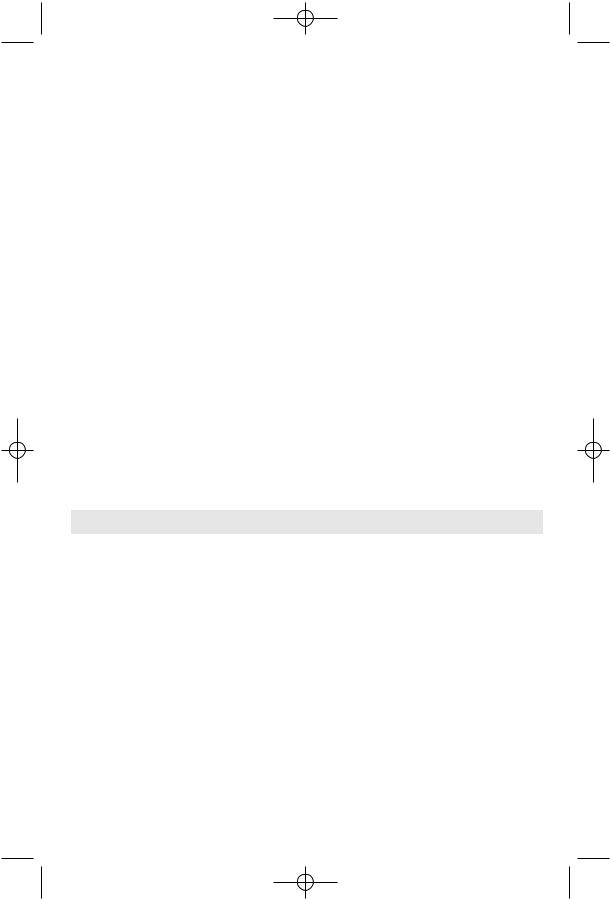
BM 3609929656 10/03 10/17/03 12:13 PM Page 3
Tool Use and Care
Use clamps or other practical way to secure and support the workpiece to a stable platform. Holding the work by hand
or against your body is unstable and may lead to loss of control.
Do not force tool. Use the correct tool for your application. The correct tool will do
the job better and safer at the rate for which it is designed.Do not use tool if switch does not turn it ìONî or ìOFFî. Any tool
that cannot be controlled with the switch is dangerous and must be repaired.
Disconnect the plug from the power source before making any adjustments, changing accessories, or storing the tool.
Such preventive safety measures reduce the risk of starting the tool accidentally.
Store idle tools out of reach of children and other untrained persons. Tools are
dangerous in the hands of untrained users.
Maintain tools with care. Keep cutting tools sharp and clean. Properly
maintained tools, with sharp cutting edges are less likely to bind and are easier to control. Any alteration or modification is a misuse and may result in a dangerous condition.
Check for misalignment or binding of moving parts, breakage of parts, and any other condition that may affect the tools operation. If damaged, have the tool serviced before using. Many accidents are
caused by poorly maintained tools. Develop a periodic maintenance schedule for your tool.
Use only accessories that are recommended by the manufacturer for your model. Accessories that may be
suitable for one tool, may become hazardous when used on another tool.
Service
Tool service must be performed only by qualified repair personnel. Service or
maintenance performed by unqualified personnel could result in a risk of injury. For example: internal wires may be misplaced or pinched, safety guard return springs may be improperly mounted.
When servicing a tool, use only identical replacement parts. Follow instructions in the Maintenance section of this manual.
Use of unauthorized parts or failure to follow Maintenance Instructions may create a risk of electric shock or injury. Certain cleaning agents such as gasoline, carbon tetrachloride, ammonia, etc. may damage plastic parts.
Safety Rules for Drivers
Hold tool by insulated gripping surfaces when performing an operation where the cutting tools may contact hidden wiring or its own cord. Contact with a “live” wire
will make exposed metal parts of the tool “live” and shock the operator. Do not drill, fasten or break into existing walls or other blind areas where electrical wiring may exist. If this situation is unavoidable, disconnect all fuses or circuit breakers feeding this worksite.
Always wear safety goggles or eye protection when using this tool.
Secure the material being fastened. Never hold it in your hand or across legs.
Unstable support can cause the drill bit to bind causing loss of control and injury.
Never leave the trigger locked "ON". Before plugging the tool in, check that the
trigger lock is "OFF". Accidental start-ups could cause injury.
Position the cord clear of rotating driver. Do not wrap the cord around your arm or wrist. If you lose control and have the cord
wrapped around your arm or wrist it may entrap you and cause injury.
Be aware of the location and setting of the switch "Lock-ON" button. If the switch
is locked "ON" during the use, be ready for emergency situations to switch it "OFF", by first pulling the trigger then immediately releasing it without pressing the "Lock-ON" button.
Be prepared for a strong reaction torque when "seating" or removing a screw. The
driver motor housing will tend to twist in the opposite direction when "seating" or removing a screw.
-3-
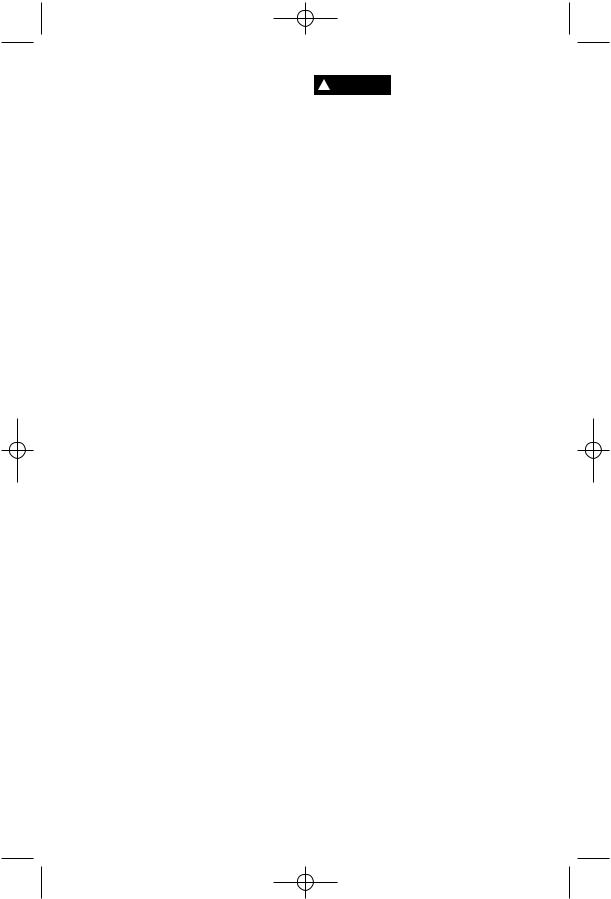
BM 3609929656 10/03 10/17/03 12:13 PM
Do not use dull or damaged bits and accessories.
Check to see that keys and adjusting wrenches are removed from the driver before switching the tool "ON". Keys or
wrenches can fly away at high velocity striking you or a bystander.
Do not run the tool while carrying it at your side. A spinning drill bit could become entangled with clothing and injury may result.
-4-
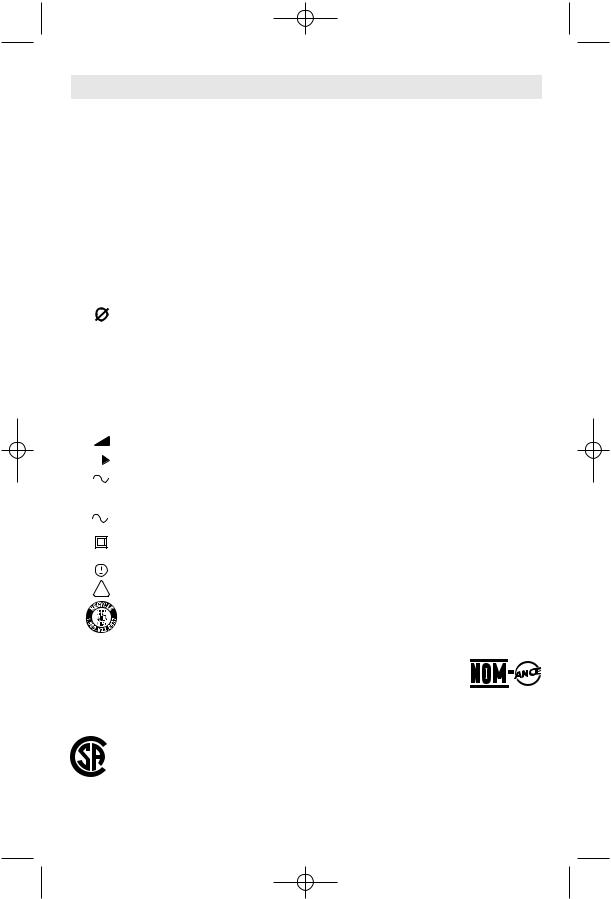
BM 3609929656 10/03 10/17/03 12:13 PM Page 5
Symbols
IMPORTANT: Some of the following symbols may be used on your tool. Please study them and learn their meaning. Proper interpretation of these symbols will allow you to operate the tool better and safer.
Symbol |
Name |
Designation/Explanation |
||||||||
|
|
|
|
|
|
|
|
|
|
|
|
|
|
|
V |
Volts |
Voltage (potential) |
||||
|
|
|
|
A |
Amperes |
Current |
||||
|
|
|
|
|
|
|
|
|
|
|
|
|
Hz |
Hertz |
Frequency (cycles per second) |
||||||
|
|
|
W |
Watt |
Power |
|||||
|
|
kg |
Kilograms |
Weight |
||||||
|
|
|
|
|
|
|
|
|
|
|
|
min |
Minutes |
Time |
|||||||
|
|
|
|
s |
Seconds |
Time |
||||
|
|
|
|
|
|
|
|
|
|
|
|
|
|
|
|
|
|
|
|
Diameter |
Size of drill bits, grinding wheels, etc. |
|
|
|
|
|
|
|
|
|
|
|
|
|
|
n0 |
No load speed |
Rotational speed, at no load |
|||||
.../min |
Revolutions or reciprocation per minute |
Revolutions, strokes, surface speed, |
||||||||
|
|
|
|
|
|
|
|
|
|
orbits etc. per minute |
0 |
|
|
|
Off position |
Zero speed, zero torque... |
|||||
|
|
|
|
|
|
|
|
|
|
|
1, 2, 3, ... |
Selector settings |
Speed, torque or position settings. |
||||||||
I, II, III, |
|
Higher number means greater speed |
||||||||
|
|
|
|
|
|
|
|
|
|
|
0 |
|
|
|
|
|
|
Infinitely variable selector with off |
Speed is increasing from 0 setting |
||
|
|
|
|
|
|
|
|
|
Arrow |
Action in the direction of arrow |
|
|
|
|
|
|
|
|
|
||
|
|
|
|
|
|
|
|
|
Alternating current |
Type or a characteristic of current |
|
|
|
|
|
|
|
|
|
|
|
|
|
|
|
|
|
|
|
|
Direct current |
Type or a characteristic of current |
|
|
|
|
|
|
|
|
|
||
|
|
|
|
|
|
|
|
|
Alternating or direct current |
Type or a characteristic of current |
|
|
|
|
|
|
|
|
|
||
|
|
|
|
|
|
|
|
|
|
|
|
|
|
|
|
|
|
|
|
Class II construction |
Designates Double Insulated |
|
|
|
|
|
|
|
|
|
||
|
|
|
|
|
|
|
|
|
|
Construction tools. |
|
|
|
|
|
|
|
|
|
|
|
|
|
|
|
|
|
|
|
|
|
|
|
|
|
|
|
|
|
|
|
Earthing terminal |
Grounding terminal |
|
|
|
|
|
|
|
|
|
||
|
|
|
|
|
|
|
|
|
Warning symbol |
Alerts user to warning messages |
|
|
|
|
|
|
|
|
|
||
|
|
|
|
|
|
|
|
|
||
|
|
|
|
|
|
|
|
|
Ni-Cad RBRC seal |
Designates Ni-Cad battery recycling |
|
|
|
|
|
|
|
|
|
|
program |
|
|
|
|
|
|
|
|
|
|
|
This symbol designates that this tool is listed by Underwriters Laboratories.
This symbol designates that this tool is listed by the Canadian Standards Association.
This symbol designates that this tool is listed to Canadian Standards by Underwriters Laboratories.
This symbol designates that this tool is listed by Underwriters Laboratories, and listed to Canadian Standards by Underwriters Laboratories.
This symbol designates that
this tool complies to NOM Mexican Standards.
-5-
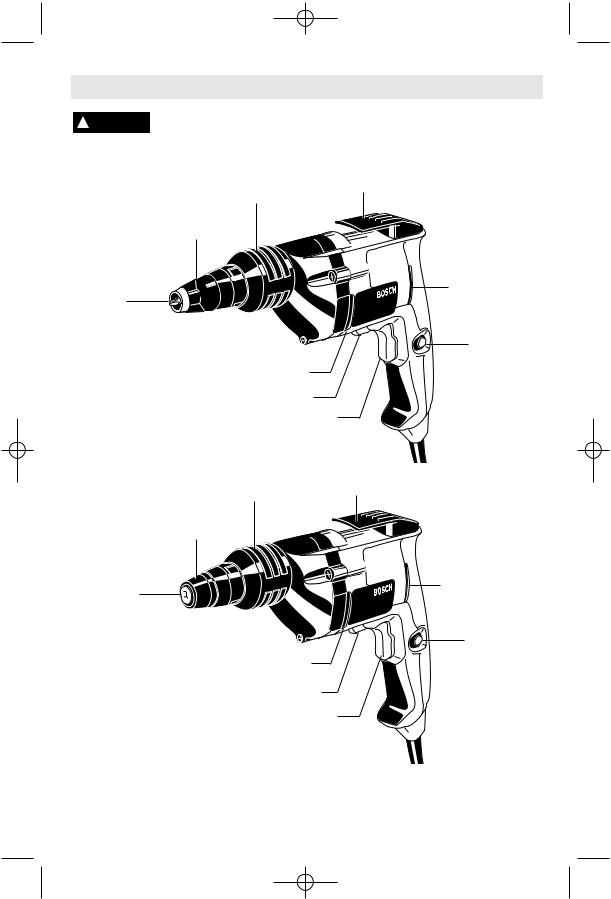
BM 3609929656 10/03 10/17/03 12:13 PM Page 6
Functional Description and Specifications
Disconnect the plug from the power source before making any ! WARNING assembly, adjustments or changing accessories. Such preventive safety
measures reduce the risk of starting the tool accidentally.
Drivers
LOCKING |
BELT CLIP |
RING |
|
NOSE |
|
PIECE |
|
|
VENTILATION |
BIT TIP |
OPENINGS |
|
|
|
ìLOCK-ONî |
|
BUTTON |
VENTILATION OPENINGS |
|
REVERSING SWITCH LEVER |
|
TRIGGER SWITCH |
|
|
LOCKING |
BELT CLIP |
|
RING |
|
|
|
|
|
NOSE |
|
|
PIECE |
|
BIT TIP |
|
VENTILATION |
|
OPENINGS |
ìLOCK-ONî
BUTTON
VENTILATION OPENINGS
VENTILATION OPENINGS
TRIGGER SWITCH
NOTE: For tool specifications refer to the nameplate on your tool.
-6-
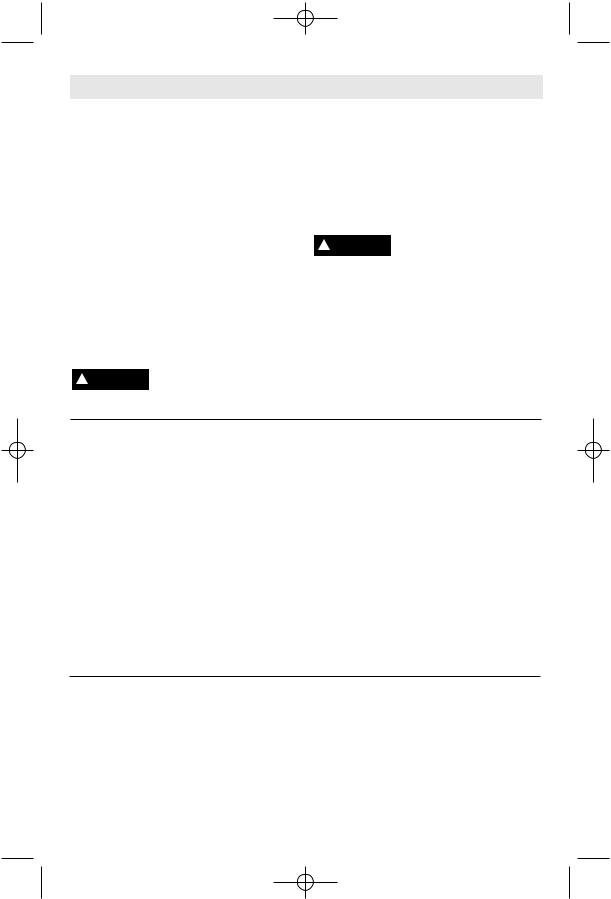
BM 3609929656 10/03 10/17/03 12:13 PM Page 7
Operating Instructions
VARIABLE SPEED CONTROLLED
TRIGGER SWITCH
Your tool is equipped with a variable speed trigger switch. The tool can be turned "ON" or "OFF" by squeezing or releasing the trigger. The speed can be adjusted from the minimum to maximum nameplate RPM by the pressure you apply to the trigger. Apply more pressure to increase the speed and release pressure to decrease speed.
"LOCK-ON" BUTTON
The "Lock-ON" button, located near the trigger allows for continuous operation at maximum RPM without holding the trigger.
TO LOCK TRIGGER "ON": squeeze trigger, depress button and release trigger.
TO UNLOCK THE TRIGGER: squeeze trigger and release it without depressing the "LockON" button.
If the “Lock-ON” button is continuously being de-
pressed, the trigger can not be released.
REVERSING SWITCH LEVER
The reversing switch lever is located above the trigger switch and is used to reverse rotation of the bit.
To use driver in "Forward" rotation, move lever to left side of tool. To "Reverse" the rotation of the bit move the lever to the right side of the tool. The center position of the lever is the "Lock-OFF" position.
! CAUTION Do not change direction of rotation until the tool comes
to a complete stop. Shifting during rotation of the chuck can cause damage to the tool.
BELT CLIP
Your tool is equipped with a belt clip that allows you to conveniently attach your driver to your belt. This feature will allow you to have both hands free when climbing a ladder or moving to another work area.
Tool Tips
1.Support the tool so that steady, even pressure is applied to the screwdriving bit. Operate the trigger switch by depressing with one or two fingers.
2.Lock the tool on for continuous operation. The bit will not rotate until the clutch is engaged.
3.Place a drywall screw on the bit. The magnetic bit holder will hold any steel drywall screw without any additional assistance.
4.Press the screw point against the drywall with steady even pressure. At this point, the clutch will engage, driving the screw to the pre-set depth. Once the screw bottoms out, a ratcheting sound will be heard for a second.
5.When properly set, the screw head should pull into the drywall paper without cracking or tearing the paper, then release slightly below flush with the drywall board. In this manner, minimum work is left when spackling screw heads and taping the seams.
6.If it becomes necessary to remove the screw, remove the snap off nose piece, reverse the direction of rotation (when the motor is in the "OFF" position.) Place the bit tip into the screw, switch tool "ON" and apply pressure to engage the clutch. Replace nose piece by pushing and slightly twisting to seat into the depth gauge. Set lever back to forward while the trigger switch is in the “OFF” position.
DEPTH CONTROL
The depth control should be adjusted so that the drywall screw is set slightly below the drywall surface.
DEPTH ADJUSTMENT
Your driver will continue to drive as long as enough pressure is applied to the bit to keep the clutch engaged. Models 1420VSR, 1420VSRL, 1421VSR, and 1422VSRQ are
-7-
equipped with a quiet clutch that eliminates ratcheting noise and prolongs clutch life.
The nose piece, upon contacting the work, prevents further pressure on the bit. Driving then stops regardless of pressure continued by the operator.
1. Pull firmly on the locking ring, moving it forward and away from the spline section of

BM 3609929656 10/03 10/17/03 12:13 PM Page 8
the clutch housing. Then turn it until the nose piece reaches the predetermined position.
2. Each 1/2 turn of the locking ring equals 1/32 inch change in depth. Once the desired depth setting is obtained, push the locking ring back toward the gear housing and turn slightly to match the splines, then push in firmly to lock it into place.
Reverse the process to the point of installing nose piece. Then WITH YOUR FINGERS, install nose piece by pushing inward. Twist if necessary to seat properly and lock in place.
|
CAPACITIES |
Model |
Nominal Capacity |
1404* |
All available sharp point drywall |
1420* |
screws in 20 - 25 gauge studs |
3. Before beginning, always test-drive a sample screw into a piece of scrap installation material to check desired depth setting.
REPLACING BIT TIPS AND
BIT TIP HOLDERS
1.Remove the plastic nose piece by grasping firmly WITH FINGERS and pulling straight out. DO NOT USE PLIERS.
2.Remove the bit tip by grasping firmly and pulling straight out. If the bit tip holder comes out with the bit, separate them. If you are replacing the bit tip holder too, grasp it firmly and pull it straight out. If you cannot remove the bit tip or the bit tip holder using fingers only, you may use pliers on these two parts only. DO NOT USE PLIERS ON NOSE PIECE.
-8-
1405 |
All available sharp point screws in |
1421 |
20 - 25 gauge studs. All available |
|
drill point drywall screws in 14 - 20 |
|
gauge studs. |
1422 |
5/16" (8mm) drill pt. |
1423 |
|
* Not recommended for 14 - 20 gauge studs and multiple board layers using drill point drywall screws. The high speed can burn drill points.
! WARNING The use of any accessory or attachment other than those
recommended in this instruction manual or the BOSCH Catalog for this tool - may create a hazard.
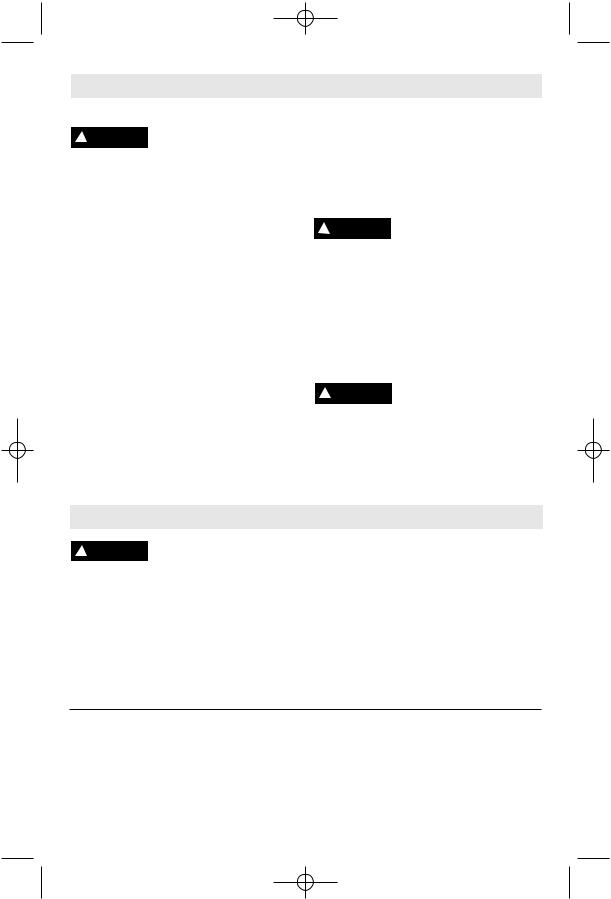
BM 3609929656 10/03 10/17/03 12:13 PM Page 9
Maintenance
Service
Preventive maintenance performed by unauthorized personnel may result in misplacing
of internal wires and components which could cause serious hazard. We
recommend that all tool service be performed by a Bosch Factory Service Center or Authorized Bosch Service Station.
TOOL LUBRICATION
Your Bosch tool has been properly lubricated and is ready to use. It is recommended that tools with gears be regreased with a special gear lubricant at every brush change.
CARBON BRUSHES
The brushes and commutator in your tool have been engineered for many hours of dependable service. To maintain peak efficiency of the motor, we recommend every two to six months the brushes be examined. Only genuine Bosch replacement brushes specially designed for your tool should be used.
BEARINGS
After about 300-400 hours of operation, or at every second brush change, the bearings
should be replaced at Bosch Factory Service Center or Authorized Bosch Service Station. Bearings which become noisy (due to heavy load or very abrasive material cutting) should be replaced at once to avoid overheating or motor failure.
Cleaning
To avoid accidents always disconnect the tool from the power supply before cleaning or
performing any maintenance. The tool may
be cleaned most effectively with compressed dry air. Always wear safety goggles when cleaning tools with compressed air.
Ventilation openings and switch levers must be kept clean and free of foreign matter. Do not attempt to clean by inserting pointed objects through openings.
Certain cleaning agents ! CAUTION and solvents damage
plastic parts. Some of these are: gasoline, carbon tetrachloride, chlorinated cleaning solvents, ammonia and household detergents that contain ammonia.
Accessories
If an extension cord is necessary, a cord with adequate size conductors that is capable
of carrying the current necessary for your tool must be used. This will prevent
excessive voltage drop, loss of power or overheating. Grounded tools must use 3- wire extension cords that have 3-prong plugs and receptacles.
NOTE: The smaller the gauge number, the heavier the cord.
RECOMMENDED SIZES OF EXTENSION CORDS 120 VOLT ALTERNATING CURRENT TOOLS
Toolís |
Cord Size in A.W.G. |
Wire Sizes in mm2 |
|||||||
Ampere |
|
|
|
|
|
|
|
|
|
Cord Length in Feet |
Cord Length in Meters |
||||||||
Rating |
|||||||||
25 |
50 |
100 |
150 |
15 |
30 |
60 |
120 |
||
|
|||||||||
3-6 |
|
|
|
|
|
|
|
|
|
18 |
16 |
16 |
14 |
0.75 |
0.75 |
1.5 |
2.5 |
||
6-8 |
18 |
16 |
14 |
12 |
0.75 |
1.0 |
2.5 |
4.0 |
|
8-10 |
18 |
16 |
14 |
12 |
0.75 |
1.0 |
2.5 |
4.0 |
|
10-12 |
16 |
16 |
14 |
12 |
1.0 |
2.5 |
4.0 |
— |
|
12-16 |
14 |
12 |
— |
— |
— |
— |
— |
— |
|
|
|
|
|
|
|
|
|
|
|
1/4" Hex Universal Bit Holder and #2 phillips bit standard equipment on drywall drivers.
1/4" Hex Universal Bit Holder and 5/16" magnetic hex nut setter standard equipment on fastener drivers.
-9-
